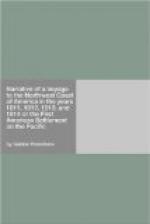INTRODUCTION.
Since the independence of the United States of America, the merchants of that industrious and enterprising nation have carried on an extremely advantageous commerce on the northwest coast of this continent. In the course of their voyages they have made a great number of discoveries which they have not thought proper to make public; no doubt to avoid competition in a lucrative business.
In 1792, Captain Gray, commanding the ship Columbia of Boston, discovered in latitude 46 deg. 19” north, the entrance of a great bay on the Pacific coast. He sailed into it, and having perceived that it was the outlet or estuary of a large river, by the fresh water which he found at a little distance from the entrance, he continued his course upward some eighteen miles, and dropped anchor on the left bank, at the opening of a deep bay. There he made a map or rough sketch of what he had seen of this river (accompanied by a written description of the soundings, bearings, &c.); and having finished his traffic with the natives (the object of his voyage to these parts), he put out to sea, and soon after fell in with Captain Vancouver, who was cruising by order of the British government, to seek new discoveries. Mr. Gray acquainted him with the one he had just made, and even gave him a copy of the chart he had drawn up. Vancouver, who had just driven off a colony of Spaniards established on the coast, under the command of Senor Quadra (England and Spain being then at war), despatched his first-lieutenant Broughton, who ascended the river in boats some one hundred and twenty or one hundred and fifty miles, took possession of the country in the name of his Britannic majesty, giving the river the name of the Columbia, and to the bay where the American captain stopped, that of Gray’s bay. Since that period the country had been seldom visited (till 1811), and chiefly by American ships.
Sir Alexander McKenzie, in his second overland voyage, tried to reach the western ocean by the Columbia river, and thought he had succeeded when he came out six degrees farther north, at the bottom of Puget’s sound, by another river.[A] In 1805, the American government sent Captains Lewis and Clark, with about thirty men, including some Kentucky hunters, on an overland journey to the mouth of the Columbia. They ascended the Missouri, crossed the mountains at the source of that river, and following the course of the Columbia, reached the shores of the Pacific, where they were forced to winter. The report which they made of their expedition to the United States government created a lively sensation.[B]
[Footnote A: McKenzie’s Travels.]
[Footnote B: Lewis and Clark’s Report.]




